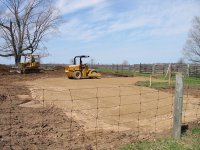Hello,
In my opinion, the following are what I consider the most important aspects of building an engineered fill in order of importance. These recommendations are assuming that all the sod has been removed prior to you starting to build your fill.
#1. The moisture content of your soil. If it is too dry, it won't compact, if it is too wet it won't compact. The best and easiest way to judge the moisture content is to grab a good handful and squeeze it into a ball. Then take and break the ball of dirt in half. if you get a good crisp break your moisture content is ideal. If it is too dry or too wet, it won't form the ball. if it is close you can decide if you need to add water or drying agent,or utilize the sun or wind
Addressing the adding of water, think of your wife mixing pancake batter. She doesn't put water on the top of the dry ingredients, and then scoops up the stuff and cook the pancakes. The batter needs to be mixed it up to get a uniform batter. The same holds true for dirt. You need to mix the dirt and water. While it can be done with a smooth front bucket, it works a lot better if you have teeth on the bucket and can stir up the fill using the teeth. If you need to dry the soil, you can use lime and mix it just like mixing water. You can also disc the fill material. The best and easiest way is using the sun and wind to dry the soil.
#2. Placing the fill. Assuming you do not have a big loader, I would recommend not over four inch lifts. It is important that you drift the soil out to nothing. Do not leave a four inch cliff, always drift it out to nothing.
#3. Compaction. Forget about Plate Compactors, Jumping Jack Compactor, or a Tow Behind Rollers. You can achieve the needed compaction by using your rubber tired tractor. Most dirt has a 86% to 90 % compaction just dumped out of the bucket. With the loader running over the fill material . Once you place a complete four inch lift run the tractor over the fill completely both ways at least twice. Then start your next lift. If you have access to a dump truck you can also run the loaded dump truck over the fill on each lift. You will easily achieve 95% compaction.
One other thing, when you are building your fill always do the edges first, then the middle. If you fill the middle first, you will always end up with much more work filling the edges. Another consideration if your building site is wet, you might consider the use of typar or other types of filter fabric over the entire area
Another important step to take is to over dig your entire area by four inches. The easiest way to accomplish this is to dig about a bucket and one half width place the material out of the way for reuse. Then take your bucket with teeth and scarify the excavated area or disc the excavated area then follow the compaction procedure before you place any fill material. After that is complete, start building your fill up to grade in lifts. Lastly build your fill a minimum of a half bucket width outside of your building area.
If you follow the above procedure you will have constructed an excellent uniform engineered fill.
Hope this helps,
Respectfully,
Benjamin J. "Joe" Browning
